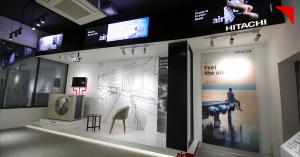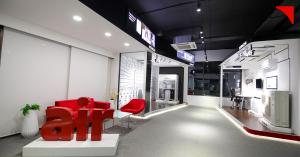D'Art Design Creates Real Time Product Experience Center for Hitachi
D'Art develops a context rich, user driven Hitachi Experience Center in Gujarat, further assisting the brand shift from static display to experiential retail.
Moving Beyond the Product Display Paradigm!
The conventional format of product demonstration—well lit stands, informative placards, and fixed signage—has dominated showroom design for decades. The launch of this Hitachi Experience Center has deliberately set aside this particular approach. Instead, it is a spatial design philosophy that values immersion as an experience rather than static interaction.
D'Art Design rolled out the Hitachi GDC's Experience Center in a way that it demonstrates a calibrated transition from the 'Product Display' to the 'Product Zone' approach. Rather than isolating products within static units, the environment encourages real time interaction with them in simulated, life like spaces. Irrespective of whether it is a living room, office, or hybrid workspace, the context has been thoughtfully embedded into the architectural flow, enabling visitors to understand how each system performs in its intended setting.
This transition from presentation to immersion seeks to add value to the product as well as the visiting experience itself. And it is yet another instance of a successful effort to break up the linearity of most traditional showroom experiences, with storytelling and functional interaction sharing the spotlight.
Structuring Experience: The Three Zone Framework
A key element of the design strategy lies in its structural zoning. D'Art Design organized the Hitachi Experience Center into three distinct but interconnected sections: Room Air Conditioner (RAC), Packaged Air Conditioner (PAC), and Variable Refrigerant Flow (VRF) systems. This division was undoubtedly mandatory for establishing operational clarity. However, it served more than that. The distinct but connected zones provide thematic cohesion, further allowing each individual category to narrate its own story within a customized spatial context.
Each of these zones uses real life scenarios to simulate how Hitachi's systems operate in homes, offices, and commercial spaces. The RAC zone, for example, is furnished like a modern living room with a wall mounted unit and digital feedback screens. In the PAC and VRF zones, wall drawings, integrated sensors, and digital interfaces work together to create the illusion of spaces that are larger and more complex, such as offices or shared public areas.
However, the approach does more than organize — it educates the visitors. It forms a narrative loop in which interested shoppers can see, play with, and learn the technological relevance of the product in the ecology where it has been designed.
One of the most difficult things about constructing this experience was making sure that the technology not only worked but explained itself. For this, D'Art leaned on a 3D visual design language and what they call a "Connectivity Display" model. Products are enabled to communicate their features and advantages without heavy textual overlays or constant human mediation.
This method of self demonstration not only simplifies the experience for the user but subtly builds technical transparency and trust. The experience center design invites curiosity and allows time bound, independent exploration, removing the pressure of sales centric interactions from the environment.
In speaking about the execution approach, a senior representative from D'Art Design commented, "We wanted to dissolve the usual boundaries between product and environment. Instead of just displaying the units, we let them speak through interaction and relevance. The developed space is not just for looking, but for understanding."
Narratives Built Around Innovation
One of the most nuanced aspects of this retail expansion is its understated narrative arc. While the spatial divisions cater to clarity and segmentation, there is an underlying unity in how all systems—regardless of type—interact with the environment and with each other.
This interconnectivity is further reinforced by interactive digital pieces, clear yet expressive spatial typography, and real use conditions layouts. The center does not come across as trying to intimidate but rather to express itself boldly in a straightforward and carefully layered presentation of information.
A complete lack of gimmicky promotional language and no branding nonsense further cements the purpose of the center—to inform by doing and to inspire by telling a quiet story.
One Step Closer to Universal Design Consistency
Hitachi's Experience Center in Gujarat is not just a localized retail environment for the brand. It is an indication of the prospect of a scalable format in retail and B2B setup across regions. The modularity and replicable layout logic embedded in the design allow this model to be adapted for different markets without compromising its central narrative.
Speaking about this strategic vision, a spokesperson from Hitachi said, "This Experience Center reflects our evolving design language—global in vision, local in relevance. It is part of our larger effort to enable our partners, consumers, and collaborators to interact with technology in ways that are both meaningful and memorable."
The Value of Execution
Much of the success of the center can be attributed to the balance between conceptual clarity and executional precision. From ambient lighting to ceiling installations and guided navigation through zones, each element has been harmonized without overshadowing the core purpose: facilitating human interaction with technology.
Every retail fixture, panel, and pathway has been calibrated to promote exploration. This also reflects D'Art's method of uniting creative ideation with tangible, built outcomes—ensuring that every aesthetic choice carries functional weight.
Mr. Chiranjivi Rajhans
D'Art Pvt Ltd
+91 75034 75038
email us here
Visit us on social media:
LinkedIn
Bluesky
Instagram
Facebook
YouTube
X
Other
Legal Disclaimer:
EIN Presswire provides this news content "as is" without warranty of any kind. We do not accept any responsibility or liability for the accuracy, content, images, videos, licenses, completeness, legality, or reliability of the information contained in this article. If you have any complaints or copyright issues related to this article, kindly contact the author above.
Studycat expands accent‑rich voice training for young learners in children Spanish language Android app
Resource Design & Build, LLC Completes Renovation at 6477 Old Shadburn Ferry Road
Naples Soccer Academy Welcomes Peter Giannopoulos as Director of Security
Więcej ważnych informacji
 Jedynka Newserii
Jedynka Newserii

 Jedynka Newserii
Jedynka Newserii

Konsument

Polacy nie korzystają z hossy trwającej na warszawskiej giełdzie. Na wzrostach zarabiają głównie inwestorzy zagraniczni
Od października 2022 roku na rynkach akcji trwa hossa, nie omija ona także warszawskiej giełdy. Mimo to inwestorzy indywidualni odpowiadają zaledwie za kilkanaście procent inwestycji, a o wzrostach decyduje i na nich zarabia głównie kapitał z zagranicy. Widać to również po napływach i odpływach do i z funduszy inwestycyjnych. Zdaniem Tomasza Koraba, prezesa EQUES Investment TFI, do przekonania Polaków do inwestowania na rodzimej giełdzie potrzeba zysków z akcji, informacji o tych zyskach docierającej do konsumentów oraz czasu.
Polityka
Obowiązek zapełniania magazynów gazu w UE przed sezonem zimowym ma zapewnić bezpieczeństwo dostaw. Wpłynie też na stabilizację cen

Unia Europejska przedłuży przepisy z 2022 roku dotyczące magazynowania gazu. Będą one obowiązywać do końca 2027 roku. Zobowiązują one państwa członkowskie do osiągnięcia określonego poziomu zapełnienia magazynów gazu przed sezonem zimowym. Magazyny gazu pokrywają 30 proc. zapotrzebowania Unii Europejskiej na niego w miesiącach zimowych. Nowe unijne przepisy mają zapewnić stabilne i przystępne cenowo dostawy.
Infrastruktura
Gminy zwlekają z uchwaleniem planów ogólnych zagospodarowania przestrzennego. Może to spowodować przesunięcie terminu ich wejścia w życie

Reforma systemu planowania i zagospodarowania przestrzennego rozpoczęła się we wrześniu 2023 roku wraz z wejściem w życie większości przepisów nowelizacji ustawy z 27 marca 2003 roku. Uwzględniono w niej plany ogólne gminy (POG) – nowe dokumenty planistyczne, za których przygotowanie mają odpowiadać samorządy. Rada Ministrów w kwietniu br. uchwaliła jednak ustawę o zmianie ustawy z 7 lipca 2023 roku, a jej celem jest zmiana terminu obowiązywania studiów uwarunkowań i kierunków zagospodarowania przestrzennego gmin na 30 czerwca 2026 roku. Wskazana data może nie być ostateczna z uwagi na to, że żadna z gmin nie uchwaliła jeszcze POG.
Partner serwisu
Szkolenia

Akademia Newserii
Akademia Newserii to projekt, w ramach którego najlepsi polscy dziennikarze biznesowi, giełdowi oraz lifestylowi, a także szkoleniowcy z wieloletnim doświadczeniem dzielą się swoją wiedzą nt. pracy z mediami.













.gif)

 |
| |
| |
|